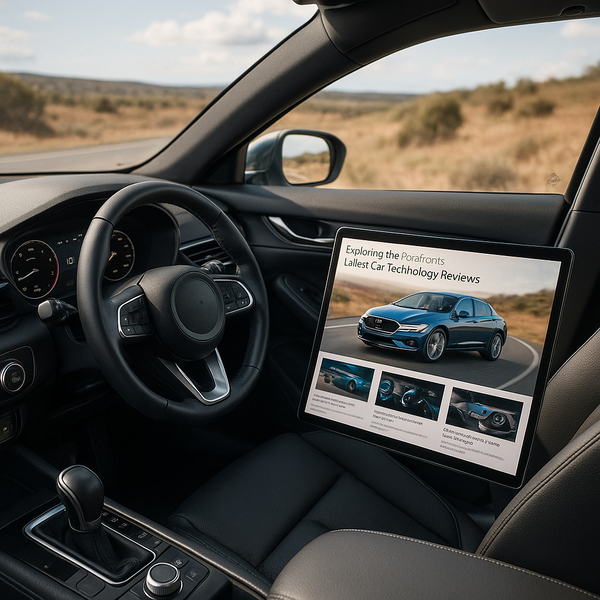
Discovering the forefront of automotive innovation is an exciting journey for any car enthusiast. The pace of technological advancement within vehicles continues to accelerate, bringing forth new features that enhance safety, connectivity, performance, and overall driving experience. From sophisticated driver assistance systems to cutting-edge infotainment and revolutionary electric powertrain technologies, the modern car is rapidly transforming into a mobile tech hub on wheels. Understanding these new developments is key to appreciating the capabilities of contemporary automobiles and making informed decisions about future vehicles.
The Evolution of Infotainment Systems
Infotainment systems have moved far beyond simple radio and CD players. Today's systems are sophisticated command centers, integrating navigation, communication, entertainment, and vehicle settings into seamless, intuitive interfaces. Touchscreens are larger and more responsive than ever, often mimicking the functionality and feel of modern smartphones and tablets. Voice recognition technology has also seen significant improvements, allowing drivers to control various functions without taking their hands off the wheel or eyes off the road. Many systems now offer wireless Apple CarPlay and Android Auto integration, providing easy access to preferred apps, music libraries, and contacts. Customization options are expanding, allowing users to tailor the display and features to their specific needs. Reviews of these systems often focus on user-friendliness, responsiveness, graphics quality, and the breadth of integrated features. The best systems are not only packed with technology but are also designed to be non-distracting and enhance the driving experience safely.
Advanced Driver Assistance Systems (ADAS) Under Review
ADAS technologies are perhaps the most significant advancements in recent automotive history from a safety perspective. These systems use an array of sensors, cameras, radar, and lidar to assist the driver in various scenarios, potentially preventing accidents or mitigating their severity. Common ADAS features include adaptive cruise control, lane keeping assist, blind-spot monitoring, automatic emergency braking, and rear cross-traffic alerts. More advanced systems offer features like traffic jam assist or even hands-free highway driving in limited conditions. Reviews of ADAS often evaluate their effectiveness, reliability, and how smoothly they intervene. A good ADAS system should feel like a helpful co-pilot, providing support without being intrusive or overly sensitive. Understanding the limitations of these systems is also crucial, as they are designed to assist, not replace, the driver's attention and control.
Connectivity and the Connected Car
Modern cars are increasingly connected, not just to your smartphone, but to the cloud and other vehicles and infrastructure. This connectivity enables a host of features, from over-the-air software updates (like those popularized by Tesla) to remote diagnostics, vehicle tracking, and even in-car Wi-Fi hotspots. Connected services can provide real-time traffic information, weather updates, and access to streaming services. Future developments point towards vehicle-to-everything (V2X) communication, where cars can communicate with each other, traffic lights, and pedestrians to improve safety and traffic flow. Reviews of connected car features assess the reliability of the connection, the usability of the services, and the value they add to the ownership experience. Data privacy and security are also growing concerns in the connected car era, and reviews may touch upon how manufacturers address these issues.
Powering the Future: EV and Hybrid Technology
Electric vehicles (EVs) and hybrids are at the forefront of powertrain technology, driving the shift towards more sustainable transportation. Latest reviews in this area focus on battery technology, range efficiency, charging speed, and the performance characteristics of electric motors and hybrid systems. Solid-state batteries, faster charging infrastructure compatibility, and improved thermal management are key areas of innovation. Hybrid technology continues to evolve with more sophisticated power management systems that optimize fuel efficiency and performance. Reviews often compare real-world range against manufacturer estimates, evaluate the charging experience (both at home and on public chargers), and analyze the driving dynamics offered by electric and hybrid powertrains. The integration of regenerative braking systems and the overall efficiency of energy recovery are also critical points in reviews.
Innovations in Automotive Safety
Beyond ADAS, car manufacturers are continuously innovating in passive and active safety features. This includes advancements in airbag systems (like frontal airbags that adapt their inflation based on occupant size and crash severity, or far-side airbags), crumple zone design, and the use of high-strength lightweight materials to improve crashworthiness without adding excessive weight. Active safety features include sophisticated traction and stability control systems, anti-lock braking systems (ABS) with electronic brakeforce distribution (EBD), and tire pressure monitoring systems (TPMS). Reviews of safety technology often refer to crash test ratings from organizations like the NHTSA and IIHS, and delve into how integrated safety systems work together to protect occupants in various crash scenarios. The implementation of pedestrian and cyclist detection systems is also becoming more common and is a key focus in safety reviews.
Lighting the Way: Advanced Automotive Lighting
Automotive lighting technology is not just about seeing; it's also about being seen and enhancing safety and aesthetics. The transition from traditional halogen bulbs to Xenon HID and now predominantly LED lighting has brought significant improvements in brightness, energy efficiency, and design flexibility. Latest advancements include adaptive headlights that pivot with the steering wheel to illuminate curves, automatic high beams that dim for oncoming traffic, and even matrix LED systems that can selectively turn off individual LEDs to create tunnels of light around other vehicles while keeping high beams on elsewhere. OLED lighting is also emerging, offering even more design possibilities for taillights and interior illumination. Reviews of lighting systems evaluate their effectiveness in various conditions, the intelligence of adaptive features, and their contribution to the vehicle's overall design and safety profile.
Exploring the latest car technology reveals a landscape of rapid and exciting change. From smarter interiors and vigilant safety guardians to efficient powertrains and dynamic lighting, the innovations shaping modern vehicles offer tangible benefits to drivers and passengers alike. Staying informed through comprehensive reviews allows consumers to appreciate the complexity and capability of contemporary automobiles and look forward to even more groundbreaking developments on the horizon.

